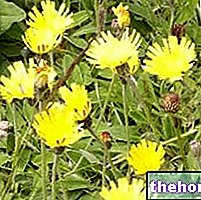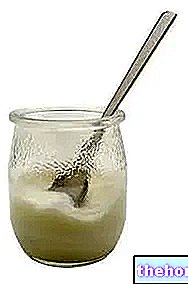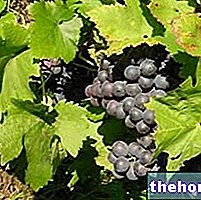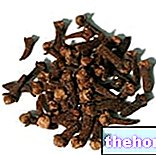Brown algae: definition
The epithet commonly attributed to the Phaeophyceae, brown algae, is due to the brownish-black color given to it by the pigments that compose them: these colored substances - known as fucoxanthin and pheochroma - perfectly camouflage the green color of chlorophyll, which tends to blacken.
Botanical description

The 1,500 species, divided into 250 genera, all differ from the morphological point of view: in fact, in the plant body (called thallus) a root, an axis and the leaves are perfectly distinguished. In the world of algae, more than root, we speak of rhizoid, capable of holding the algae attached to the substrate; the axis is called cauloid, while the leaves - branched, extended and quite broad - are known as phyllodes.
Brown algae can be made up of two types of thalli: the apoplastic, which represents the most simplified thallus, and the hypoplastic, considerably more complex (cell divisions occur in every direction of space). Chloroplasts are made up of photosynthetic membranes, divided, in turn, into lamellae with thylakoids; the membrane is made up internally of cellulose and externally of alginic acid.
Depending on the family to which they belong, brown algae have a different mode of reproduction.
Chemical composition
Brown algae, such as green and red algae, also contain chlorophyll (specifically, type a and c) as well as being particularly rich in carotenes (including beta-carotene and xanthophylls) and other accessory pigments (fucoxanthin). The particular chemical composition of brown algae allows photosynthesis to be carried out even in the depths of the ocean, areas where the solar spectrum does not reach it completely. The cell cytoplasm is composed of a polysaccharide, known as laminaran.
Brown algae produce large quantities of mucilage (eg alginates), very useful for maintaining algal hydration.
Brown algae are rich in carbon hydrates and iodine: due to their large amount of iodine, brown algae have been widely exploited since the past for the treatment of endemic goiter (hypothyroidism). In particular, we remember the Kalm seaweed, the Kombu seaweed and the Kelp seaweed: the richness in terms of iodine is exploited in phytotherapy in order to stimulate the thyroid gland.
It should be remembered that herbal products based on brown algae (and algae rich in iodine in general) must be used with extreme caution even by those suffering from hypothyroidism: overdosing could in fact cause situations of hyperthyroidism, associated with alterations of the "mood, tremors, thyroid dysfunction, tachycardia and arterial hypertension.
Employments
As mentioned in the previous paragraph, the most important property attributable to brown algae is related to the "huge amount of iodine contained in them: in this regard, brown algae are widely used by the herbal and pharmaceutical industry for the production of anti-algae products" hypothyroidism and metabolism stimulants in general (widely used in slimming supplements) Furthermore, it seems that brown algae boast mild diuretic properties, as well as decongesting the urinary tract (internal use).
We have seen that brown algae are made up of alginates: they are mucilaginous substances, useful for the formulation of herbal and pharmaceutical products adjuvants of low-calorie diets (mainly satiating properties).
Alginic acid is also used in the food industry, in particular for the production of ice cream.
Brown algae are also used in agriculture as excellent organic fertilizers.
Summary
Brown algae: in short
- Habitat: they live in marine environments, in particular in cold and oxygenated waters
- There are 1,500 species divided into 250 genera
- Morphology: distinction of root (rhizoid), axis (cauloid) and leaves (phylloids)
- Thallus: hypoplastic and apoplastic
- Membranes: photosynthetic, divided into lamellae with thylakoids
- Membrane composition: cellulose (internal part) and alginic acid (external part)
- Cell cytoplasm: composed of laminaran (polysaccharide)
- Chlorophyll type a and c
- Carotenes (including beta-carotene and xanthophylls)
- Accessory pigments (fucoxanthin)
- Polysaccharide (laminaran)
- Mucilage (eg. Alginates)
- Carbon hydrates
- Iodine
Overdose → hyperthyroidism, mood changes, tremors, thyroid dysfunction, tachycardia, high blood pressure and lethargy
- Formulation of products against hypothyroidism
- Blande diuretic properties
- Decongestants of the urinary tract
- Adjuvants of low-calorie diets (thanks to alginates)
- Food industry (ice cream production)
- Agriculture: excellent organic fertilizers
Select plant Fir Acacia Acerola Sorrel Yarrow Yarrow Yarrow Aconito Adatoda Garlic Agnocasto Agrimonia Alchemilla Alkekengi Aloe Altea Witch Hazel Ammi or Visnaga Pineapple Andrographis Anemone Pulsatilla Angelica Anise Star Anise Japanese Star Anise Bitter Orange Bitter Areca Arnica Harpagophytum Arpagophyte Artemisia Asteragus Basil Asparagus Asparagus Peruvian Asparagus Asparagus Asparagus Hawthorn Boldo Borage Shepherd's Purse Boswellia Bucco Butea superba Cocoa Coffee Cajeput Calamus Calamus Marigold Camedrio Chamomile Roman Chamomile Camphor Cinnamon Ceylon Maidenhair Capuchin Artichoke Cardamom Cardiac Thistle Asian Thistle Carvi Cascara Cassia Catecu Catha Cabbage Celandine Chicory Centaurea Cinnamon Cypress Celandine Chives Cypress Coca Cola Colchico Combreto Condurango Comfrey Coriander Cranberry Barberry American Chrysanthemum Cumin Turmeric Damiana Digital Dioscorea Drosera Dulcamara Dunalilella Echinacea Eder a Ephedra Elenio Eleutherococcus Helichrysum Evening primrose Horsetail Alfalfa Erica Euphrasia Erisimo Escolzia Eucalyptus Farfara Farfaraccio Calabar bean Fenugreek Fennel Phytolacca Frangola Ash Fumaria Japanese Mushrooms Galega Ganoderma lucidum Garcinia Cambogia Mulberry Gentian Broom Ginkgo Ginkgo Guipana Guipana Gynestra Ginkgo Hibelia Gymnasium Hibiscus Guarulp St. John's Wort Horse Chestnut Ispaghul Hyssop Jaborandi Kava kava Konjac Laminaria Cherry Laurel Lavender Lemongrass Lespedeza Lovage Icelandic Lichen Lemon Flax Lippia Licorice Lobelia Hops Maca Marjoram Maize Mallow Manna Marrubio Marrubio d "water Matè Melaleuca Meliloto American Lemon balm Myrtle Myrama Walnut Nutmeg Walnut vomica Olive tree Meadowsweet Ononide Opuntia Oregano Orthosiphon Nettle Poppy Papaya Parietaria Feverfew Passiflora Chilli Perilla Periwinkle Phyllanthus Plantain Picrorhiza Pilosella Pino Pisci dia Podofillo Polygala Grapefruit Parsley Psyllium Pueraria mirifica Butcher's broom Pygeum Quassia Oak Rhubarb Ratania Rauwolfia currant Castor bean Rhodiola Rosehip Rosemary Rue Willow Sarsaparilla Sage Elderberry Sassafras Sedum Ergot Senna Serenoa Repens Soybean Solidago Tansy Taraxus Tamarind Tamarind Tamarind Tamarind Tamarindo Ursina Valerian Vanilla Mullein Verbena Veronica Viburnum Vinca Pansy Mistletoe Vine Withania Yohimbe Saffron Ginger Pumpkin Select disease Juvenile Acne Rosacea Tinnitus Tinnitus Aerophagia Tendon Affections Afonia Aphthae Algias Functional Halitosis Breastfeeding Allergy Anemia Anguish Anxiety Arteriosclerosis Asthrosis Asthrosis Arthritis Arthritis Men Sex Woman Blepharitis and Conjunctivitis Eye bags Bronchitis Gallstones Kidney stones Salivary stones Baldness Androgenetic Candida Fragile hair Caries Headache Cellulitis Motion sickness Cystitis C limaterio Cholecystopathy High cholesterol Ulcerative colitis Colonoscopy Contusions Hematoma Convalescence Couperose Depression Dermatitis Diaper dermatitis Diabetes Diarrhea Erectile dysfunction Dyslipidemia Dysmenorrhea Dyspepsia Disturbances of vision Hemorrhoids Epistaxis Herethism Heart disease Fever Fibromyalgia Gastro-intestinal disease Flatulence Hypertension Fibromyalgia Gastrointomnia Jaundice Laryngitis Renal lithiasis Toothache Sore throat Thinness Menopause Meteorism Mononucleosis Alzheimer's disease Crohn's disease Nausea Vomiting Obesity Dark circles Onychomycosis Osteoporosis Dry skin Periarthritis Piorea Low pressure Prostatitis Psoriasis Colds Breast fissures Anal fissures Gastro-nasal rhinitis Senescence Premenstrual Syndrome Sinusitis Quit smoking Overweight Fatty liver Constipation Stomatitis Stress Cough Triglycerides high Ulcer Burns Nails Brittle flashes Heat Warts Dizziness Properties herbal Tanning Abortive adaptogenic Aphrodisiac bittering analgesic anesthetic anorectics analgesic antacid anti-allergic anti-asthmatic Antibiotic catarrh Anticellulitiche anticonvulsant Antidiaforetiche antidiarrheal edematous anthelmintic antiemetic Antiemorroidarie antiphlogistic Antiidrotiche Antinevrotiche Antioxidants antipyretic antirheumatic antiscorbutic Antiseptic antispasmodic anti-uric Aperitive Flavoring Astringent Balsamic Bechiche Capillarotrope Cardiotonic Carminative Cathartic Caustics Healing Cholagogues Choleretic Dyes Decongestants Deodorants Purifying Diaphoretic Cleansers Disinfectants Detoxifiers Thirst quenching Diuretics Exciting Emetics Emmenagogues Emollients Hemostatic Energies Hepatoprotectors Expectorants Eupepticus Moisturisers Galactosensitizers lanti Hypertensive Hypnotic Hypoglycemic Hypotensive Irritants Laxatives Soothing Narcotic Nerves Nutrients Odontalgic Pectoral Purgative Revulsive Remineralizing Refreshing Rubefacient Scialagoghe Sedative Soporifugas Sneezing Stomachic Stomatics Narcotic Vascular Tightenitis























-nelle-carni-di-maiale.jpg)




